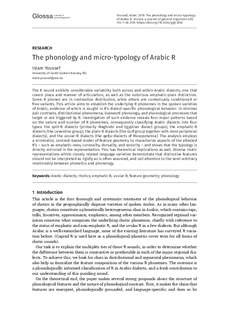| dc.contributor.author | Youssef, Islam | |
| dc.date.accessioned | 2020-01-30T09:04:04Z | |
| dc.date.available | 2020-01-30T09:04:04Z | |
| dc.date.created | 2019-11-22T19:08:37Z | |
| dc.date.issued | 2019 | |
| dc.identifier.citation | Glossa: a journal of general linguistics. 2019, 4 (1), 1-36. | nb_NO |
| dc.identifier.issn | 2397-1835 | |
| dc.identifier.uri | http://hdl.handle.net/11250/2638781 | |
| dc.description | This is an open-access article distributed under the terms of the Creative Commons Attribution 4.0 International License (CC-BY 4.0), which permits unrestricted use, distribution, and reproduction in any medium, provided the original author and source are credited. | nb_NO |
| dc.description.abstract | The R sound exhibits considerable variability both across and within Arabic dialects; one that covers place and manner of articulation, as well as the notorious emphatic-plain distinction. Some R phones are in contrastive distribution, while others are contextually conditioned or free variants. This article aims to establish the underlying R phonemes in the spoken varieties of Arabic, evidence of which is sought in R’s dialect-specific phonological behavior: in minimal pair contrasts, distributional phenomena, loanword phonology, and phonological processes that target or are triggered by R. Investigation of such evidence reveals four major patterns based on the nature and number of R phonemes, consequently classifying Arabic dialects into four types: the split-R dialects (primarily Maghrebi and Egyptian dialect groups), the emphatic-R dialects (the Levantine group), the plain-R dialects (the Gulf group together with most peripheral dialects), and the uvular-R dialects (the qeltu-dialects of Mesopotamia). The analysis employs a minimalist, contrast-based model of feature geometry to characterize aspects of the attested R’s – such as emphatic-ness, coronality, dorsality, and sonority – and shows that the typology is directly mirrored in the representation. This has theoretical implications as well. Diverse rhotic representations within closely related language varieties demonstrate that distinctive features should not be interpreted as rigidly as is often assumed, and call attention to the semi-arbitrary relationship between phonetics and phonology. | nb_NO |
| dc.language.iso | eng | nb_NO |
| dc.rights | Navngivelse 4.0 Internasjonal | * |
| dc.rights.uri | http://creativecommons.org/licenses/by/4.0/deed.no | * |
| dc.title | The phonology and micro-typology of Arabic R | nb_NO |
| dc.type | Journal article | nb_NO |
| dc.type | Peer reviewed | nb_NO |
| dc.description.version | publishedVersion | nb_NO |
| dc.rights.holder | © 2019 The Author(s). | nb_NO |
| dc.source.pagenumber | 1-36 | nb_NO |
| dc.source.volume | 4 | nb_NO |
| dc.source.journal | Glossa: a journal of general linguistics | nb_NO |
| dc.source.issue | 1 | nb_NO |
| dc.identifier.doi | 10.5334/gjgl.1002 | |
| dc.identifier.cristin | 1751265 | |
| cristin.unitcode | 222,59,2,0 | |
| cristin.unitname | Institutt for språk og litteratur | |
| cristin.ispublished | true | |
| cristin.fulltext | original | |
| cristin.qualitycode | 2 | |

